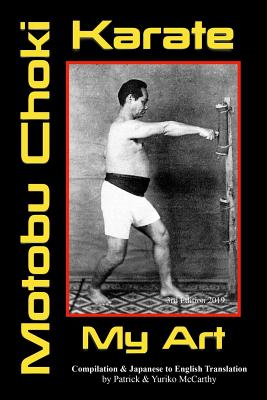Karate My Art by Motobu Choki: Watashi No Karate-Jutsu

Karate My Art by Motobu Choki: Watashi No Karate-Jutsu
At long last we are pleased to announce that the 3rd edition of the 1932 Motobu Choki publication, "Watashi no Karate-jutsu," is finally completed thanks only to the assistance and co-operation of many kind people. The publication is approximately 182 pages in the same size and format as our Funakoshi Gichin publication, Tanpenshu. Here, in this small but provocative publication, lies yet another milestone in the legacy of Karate. "Watashi no Karate-jutsu" ("My Art of Karate"), introduces comprehensive insights into a fighting tradition as known and taught by one of its early Okinawan innovators, Motobu Choki (1870-1944). One of only two books he ever published on the art it is not widely known in modern karate circles or outside the spectrum of those who research its history. Straightforward in its approach, this modest work outlines those unique methods that made Motobu Choki, pound for pound, possibly the greatest technician and karate fighter of his generation. One mistake the modern Karate-ka often makes, when trying to grasp the technical ambiguities surrounding the application of early karate practices, is to depend on contemporary assumption. This small but powerful book provides a window through which the reader is better able to perceive the cultural landscape and social mind-set of those people who shaped its practice. What could possibly improve a reader's overall understanding of the art more than walking in the footsteps of those people most responsible for pioneering it? Great people should never be forgotten, if only to remind us of the potential latent in ourselves. By studying the anthropology of this tradition it becomes evident that many of the early pioneers established a symbiosis with karate so that their lives became as much a product of the art as was the art a product of their lives. Researched and translated by Patrick & Yuriko McCarthy
PRP: 255.36 Lei
Acesta este Pretul Recomandat de Producator. Pretul de vanzare al produsului este afisat mai jos.
229.82Lei
229.82Lei
255.36 LeiLivrare in 2-4 saptamani
Descrierea produsului
At long last we are pleased to announce that the 3rd edition of the 1932 Motobu Choki publication, "Watashi no Karate-jutsu," is finally completed thanks only to the assistance and co-operation of many kind people. The publication is approximately 182 pages in the same size and format as our Funakoshi Gichin publication, Tanpenshu. Here, in this small but provocative publication, lies yet another milestone in the legacy of Karate. "Watashi no Karate-jutsu" ("My Art of Karate"), introduces comprehensive insights into a fighting tradition as known and taught by one of its early Okinawan innovators, Motobu Choki (1870-1944). One of only two books he ever published on the art it is not widely known in modern karate circles or outside the spectrum of those who research its history. Straightforward in its approach, this modest work outlines those unique methods that made Motobu Choki, pound for pound, possibly the greatest technician and karate fighter of his generation. One mistake the modern Karate-ka often makes, when trying to grasp the technical ambiguities surrounding the application of early karate practices, is to depend on contemporary assumption. This small but powerful book provides a window through which the reader is better able to perceive the cultural landscape and social mind-set of those people who shaped its practice. What could possibly improve a reader's overall understanding of the art more than walking in the footsteps of those people most responsible for pioneering it? Great people should never be forgotten, if only to remind us of the potential latent in ourselves. By studying the anthropology of this tradition it becomes evident that many of the early pioneers established a symbiosis with karate so that their lives became as much a product of the art as was the art a product of their lives. Researched and translated by Patrick & Yuriko McCarthy
Detaliile produsului








